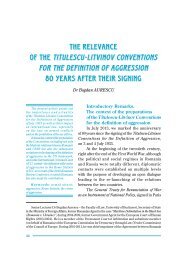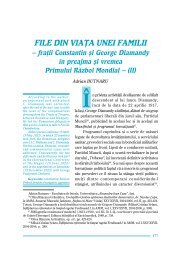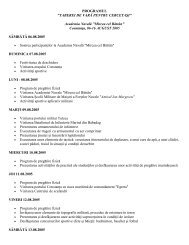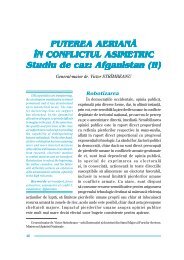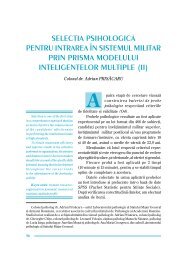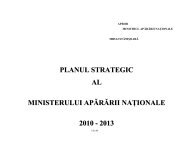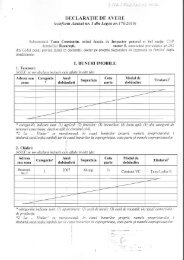Create successful ePaper yourself
Turn your PDF publications into a flip-book with our unique Google optimized e-Paper software.
mastership extended, based on coins discoveries,<br />
in regions Buzău and Putna. 23 Demonstration was<br />
also sustained by the contemporary testimony by<br />
Trogus Pompeius/Iustinus of another Getic King –<br />
Oroles 24 – whose domination was on the path of<br />
Bastarns. In a large view of Centuries III-I, the<br />
professor did not restrain to affirm the existence<br />
of a “Pontic policy” of the Getic kings. 25<br />
Whether, as the inscription shows, in the great<br />
policy, Histropolitanians were looking for the support<br />
of Getic kings from across Istros, valorization<br />
of rural territory was based on cohabitation with<br />
“Barbarians”, local Getae, sheltered in the city in<br />
hard times and ready to enroll volunteers for common<br />
defense. 26 This reference enabled Professor<br />
D.M. Pippidi to reject the opinion, of Marxistleninist<br />
origin, of the rural territory of Greek cities<br />
exploitation with numerous agrarian slaves. 27<br />
The virulent Thracian threat at the edge of centuries<br />
III/II was not followed by a calm period, Scythia<br />
Minor being probably the path that connected some<br />
Bastarnic tribes with the Kingdom of Macedonia so<br />
that these put themselves in service of kings<br />
Philippos V, Demetrios II and Perseus.<br />
The same Bastarnic pressure at Istros would<br />
have pushed toward South Scythic tribes, whose<br />
leaders are known as “kings” according to their<br />
coins: Ailios, Kanites, Sariakes, Tanusa, Akrosas,<br />
Charaspes. Probably, more important of them was<br />
Kanites, mentioned also by a decree in Odessos, in<br />
the II nd Century, regarding the Greek commerce<br />
in the lands controlled by him. 28 It is not to be<br />
excluded that to these times of domination by these<br />
Scythic leaders be attributed some archaeological<br />
discoveries of the important settlement in Albeşti,<br />
in the Callatian chora.<br />
The interdependency between Pontic Greek<br />
cities, resulted from the economic unity of the<br />
Black Sea, more and more accentuated in the<br />
Hellenistic age, appears also during the serious<br />
conflict that broke out in the first half of the II nd<br />
Century B.C. between Apollonia and Mesembria<br />
upon the port Anchialos. Thanks to the alliance,<br />
concluded one century prior, between Apollonia<br />
and Histria, the Milesian colony was called for<br />
help when Mesembrians, without any war declaration,<br />
occupied the territory and the city<br />
Anchialos. Built by Apollonians, the stronghold and<br />
the borough were meant to ensure their control<br />
upon Burgas Gulf, natural outlet of some commercial<br />
roads in the Balkans. Intervention by<br />
Istropolitans did not delay. Long ships under the<br />
command of admiral Hegesagoras of Monimos<br />
����� Review of Military History �����<br />
cooperated with Apollonians in defending the territory,<br />
the city and the ports. Ulterior, through<br />
common efforts by other unnamed allies, the enemy<br />
fleet that was defending Anchialos was defeated<br />
– a naval fight where Histrian admiral evidenced<br />
by capturing one ship with its entire crew.<br />
Following this victory, the allies landed under the<br />
city assaulting and completely destroying it,<br />
Hegesagoras was excelling through his courage<br />
and skillfulness in leading the fighters on this occasion.<br />
His merits were rewarded not only by coronation<br />
with the golden wreath on the feast of<br />
Dionysos, but also through construction of his<br />
bronze statue, presenting him armed at the ship’s<br />
bow, placed in the temple of Apollo Medicus (the<br />
Healer), the decree that sanctions the facts being<br />
fixed on the base. Apollonians’ acknowledgement<br />
was also recorded in Histria through an inscription<br />
on a marble stone, discovered during the archeological<br />
excavations in 1958. 29<br />
Fruitful affinity between Greek cities in North-<br />
Western Pontus, martially illustrated by the above<br />
named decree, is also registered in other epigraphic<br />
testimonies from Histria. Here appeared inscriptions<br />
in honor of some Tomitans, Callatians, Apollonians,<br />
and of one inhabitant of Byzantium and Cyzic. 30 A<br />
decree from Tomis was rewarding the merits of one<br />
inhabitant of Tyras for sustaining the interests of<br />
Tomitans in his city. 31 Moreover, Tomitan merchants<br />
were welcomed in Odessos.<br />
Despite Memnon’s testimonies, picking probably<br />
an information contemporary to events, the<br />
confrontation between the Callatian-Histrian alliances<br />
with Bizantium, in the first half of the III rd<br />
Century B.C., did not provoke the definitive collapse<br />
of city Callatis. On the contrary, in the II nd<br />
Century its economic role is dominant, clearly<br />
outrunning Histria. Benefiting by an impressive<br />
perimeter and by a not less secure port, the businesses<br />
of merchants from Callatis flourish, different<br />
testimonies attesting this at Tyras Olbia, Tauric<br />
Chersones, Dyonisopolis, Apollonia, Byzantium,<br />
Parion in Troada, Mytilene, Delos, Delfi, and Alexandria.<br />
In the same measure are edificatory, for<br />
the knowledge of commercial relations of the Greek<br />
cities, the archeological discoveries of some<br />
handcrafted products, whose provenience can be<br />
dated based on <strong>sea</strong>ls or inscriptions. Among the<br />
most precious of these testimonies there are the<br />
<strong>sea</strong>led amphorae attesting imports from the great<br />
centers of production – Sinope, Thassos, Rhodos,<br />
Cnidos, Cos, of these useful pots, especially for oils,<br />
wines and other products transported by ships.<br />
13



